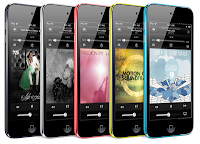IPOD MODELS
IPOD MODELS
1st Generation iPod
 |
| IPOD MODELS |
The 1st generation iPod is the first iPod mock-up
by Apple announced on October 23, 2001,
the price of the original iPod was $399 with a 5 GB hard drive. Critics panned the unit's price, but it proved
an immediate hit in the market, rapidly overtaking previously hard drive MP3
players such as the NOMAD Jukebox. In March 2002 Apple announced a 10 GB version priced at $499.Apple
intended a automatic scroll wheel and outsourced the realization and progress to Synoptic, a firm which also urbanized the track
pad for Apple's Power Books. The 1st generation iPod featured four buttons
(Menu, Play/Pause, Back, and Forward) set around the limits of the scroll
wheel, and one Select button in the middle.
2nd Generation iPod
The 2nd generation iPod came in 10 GB and 20
GB capacities and was introduced on July 17, 2002,
at Macworld, and the involuntary scroll wheel of the original was replaced with a touch-sensitive,
non-mechanical one (pretend by Synaptic), termed a "touch circle”. Due to new Toshiba hard drives, the 20 GB iPod slightly exceeded its 1st generation complement in width and weight, while the 10 GB model was slimmer. It came with a transportation case and wired inaccessible and it was the first one that was well-matched with Windows. In December 2002 Apple unrestricted 4 limited-edition, laser-engraved, autographed iPods from Beck, Tony Hawk, Madonna, and No hesitation. They sell for $50 over the normal put on the market price in each ability until it was discontinued.
at Macworld, and the involuntary scroll wheel of the original was replaced with a touch-sensitive,
non-mechanical one (pretend by Synaptic), termed a "touch circle”. Due to new Toshiba hard drives, the 20 GB iPod slightly exceeded its 1st generation complement in width and weight, while the 10 GB model was slimmer. It came with a transportation case and wired inaccessible and it was the first one that was well-matched with Windows. In December 2002 Apple unrestricted 4 limited-edition, laser-engraved, autographed iPods from Beck, Tony Hawk, Madonna, and No hesitation. They sell for $50 over the normal put on the market price in each ability until it was discontinued.
3rd Generation iPod
The 3rd generation iPod featured the four
buttons above the touch sweep with "select" in the center
and to some extent smaller than its predecessors and was introduce by Apple CEO Steve Jobs on April 28, 2003. They had more characteristically beveled edges and Apple twisted 10 GB, 15 GB, 20 GB, 30 GB, and 40 GB versions. These iPods use a 30-pin connector called the tie up Connector (longer and flatter than a FireWire connector). The iPod Dock came bundled with all but the least classy iPod and also retailed unconnectedly. It featured touch-sensitive buttons placed between the display and touch sweep. The new buttons featured red backlighting, allowing easier use in shadows. The touch-sensitive buttons, which was built upon the touch-sensitive spool wheel introduce in the 2nd generation iPod, makes it only one of its kind in that it has no external moving parts (other than the hold slider on the top of the unit) and is the only iPod that doesn't have its buttons neighboring the wheel. Apple stopped shipping take apart Mac and Windows versions of the unit and in its place, all iPods were shipped with their hard drives formatted for Macintosh use; they included CD-ROM featuring a Windows value which could be reformatted for use with a Windows PC.
and to some extent smaller than its predecessors and was introduce by Apple CEO Steve Jobs on April 28, 2003. They had more characteristically beveled edges and Apple twisted 10 GB, 15 GB, 20 GB, 30 GB, and 40 GB versions. These iPods use a 30-pin connector called the tie up Connector (longer and flatter than a FireWire connector). The iPod Dock came bundled with all but the least classy iPod and also retailed unconnectedly. It featured touch-sensitive buttons placed between the display and touch sweep. The new buttons featured red backlighting, allowing easier use in shadows. The touch-sensitive buttons, which was built upon the touch-sensitive spool wheel introduce in the 2nd generation iPod, makes it only one of its kind in that it has no external moving parts (other than the hold slider on the top of the unit) and is the only iPod that doesn't have its buttons neighboring the wheel. Apple stopped shipping take apart Mac and Windows versions of the unit and in its place, all iPods were shipped with their hard drives formatted for Macintosh use; they included CD-ROM featuring a Windows value which could be reformatted for use with a Windows PC.
4th Generation iPod
 |
| IPOD TOUCH BLACK |
The 4th generation iPod incorporated the four
buttons into the scroll wheel and it's measured the model in Which sales
greatly improved, thus starting the "iPod Craze". In the most understandable
difference from its predecessors, the 4th generation iPod carries over the
click-wheel design introduce on the iPod Mini and was introduced in July
2004.Some users criticized the click wheel because it does not have the taillight
that the 3rd generation iPod buttons had, but others noted that having the
buttons on the range points basically removed any need for backlighting. Apple
also claimed that updated software in the new iPod allows it to use the battery
more powerfully and increase battery life to 12 hours. Other minor changes
included the accumulation of a "Shuffle Songs" option on the
top-level menu to make it more expedient for users. After many requests from
users asking for these improvements to function on earlier iPods as well, Apple
on February 23, 2005, on the rampage a firmware update which brings the new
menu items to 1st-3rd generation iPods? Originally, the 4th generation iPod had
a neutral screen and no photo capabilities, like its predecessors. It came in
20 GB and 40 GB sizes. In February 2005 Apple discontinued the 40 GB model and
began exclusively selling a toneless 20 GB version. The monochrome 4th
generation iPod, slightly thinner (about one millimeter less) than the 3rd
generation iPod, introduced the skill to charge the battery over a USB relationship.
5th Generation iPod
The 5th generation iPod is often called the
iPod video or the video iPod was on the loose on October 12, 2005 and it's existing
in 30 GB and 60 GB capacity models. It has the skill to play MPEG-4 and H.264 video with resolutions
of up to 480 x 480 (maximum macro block (16x16 pixel) count of 900) and 320 x
240 (maximum macro block (16x16 pixel) count of 300), in that order (videos
purchased from the iTunes Music Store are narrow to 320 x 240).You can play
widescreen resolutions up to 640x360 using MPEG-4 and 400 x 192 using H.264
(total macro block add up falls within the stated maximums).5th generation
models have a 65,536 color (16-bit) screen, with a 320 x 240 QVGA transflective
TFT display, and are able to display video on an outside TV via the AV cable ornament,
which plugs into the headphone maniac and splits into merged video and audio
output connectors with RCA jacks. It can also display video on an peripheral TV
using the iPod AV or S-video cables with the iPod worldwide Dock. The size are
103.5 x 61.8 x 11.0 mm for the 30 GB version, and 103.5 x 61.8 x 14.0 mm for
the 60 GB version. The screen size is now 2.5 inches (6.35 cm) slantwise, 0.5
inches (12.7 mm) larger than the earlier iPod. It is 30% thinner than the earlier
full-size iPod. The battery life for the 30 GB is 14 hours and for the 60GB is approximately
20 hours. Watching movies reduces that amount to 2 and 3 hours in that order.
The click wheel design is the same as the earlier generation, but is slightly
smaller (1.5" diameter) than before. The new click wheel is totally flat,
unlike older models where the center button is slightly smoothed and raised.
Apple stopped producing iPods with the click wheels used in the 4th generation
iPod and iPod Mini from their earlier supplier, Synaptic, and now use an
in-house explanation. Like the iPod Niño, the 5th generation iPod comes in two
colors, white and black, and it facial appearance the World Clock, Stopwatch,
and Screen Lock applications. In addition, the earphone plug is smaller and
comes with a thin slip case, most expected in reply to many complaints with
reference to the iPod Niño’s easily-scratched surface. Apple also discontinued
the addition of an AC adapter and FireWire cable and you must buy this item
separately in order to charge the iPod from a household channel, or use an
external, powered USB hub. The 5th generation iPod no longer supports file
transfers via FireWire, but still supports charging using FireWire. This is
most to be expected due to the better fame of Hi-Speed USB 2.0 in the consumer
market as well as lessening developed component costs by lowering the difficulty
of the circuit boards and removing unnecessary garnishing.




